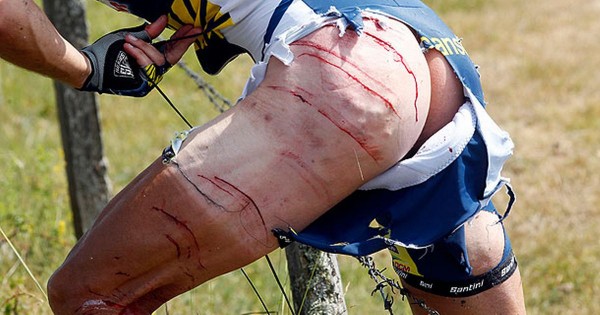This last few days has been sad for the sport of bicycle racing. Three riders have died this past week while racing. Two riders in Europe, then another rider here in the US. This isn’t normal and it does give one some chance to think about our dedication and participation in the sport.
The death that seems to be getting the most attention is that of Antoine Demoitié. He was hit by a race motorcycle after crashing with 3 other riders during Gent-Wevelgem.
One other young rider, Daan Myngheer died after suffering a heart attack at the Critérium International. Then 29-year-old Randall Fox, an Oregon State Ph.D. student, died after crashing in Washington.
Man, how tragic for all involved.
All people that make their living racing bicycles have to have been affected by this. All riders that have deep love of the sport and spend most their waking hours breathing and living the sport, are in the same situation. It makes us all rethink the risks we’re willing to take to participate in a sport.
Marcel Kittle wrote a long post on Facebook that mainly addresses the safety issues and mainly the death of Antoine Demoitié. His post is here. This is probably a good time to address perceived problems that our sport has.
Marcel seems to be mainly concerned with outside sources. He goes on to name the situations and riders that have had accidents from race motorcycles and such. In his post, Marcel makes this statement – Cycling´s biggest problem was doping and still has to be fought. But the safety issues that are obvious, should get the same attention and priority as the fight for clean sport.
Marcel has good/great intentions here. He is expressing his concerns over the safety of all involved. But this line is too strong for my liking. Safety issues getting the same attention and priority as doping is a dramatic statement and if he truly means that, he is posting from an emotional stance and not an intellectual one.
Marcel states that bicycle racing has always been a dangerous proposition. I agree with this completely. But saying that a rider should be more concerned about crashes from outside sources, ie. road furniture, race caravan, etc,. is shifting the safety blame to another subject.
He says – There is a difference between riders crashing in the last hectic kilometres of a race, fighting for the right wheel before the sprint and riders crashing because of unsafe road furniture, reckless driving of motorbikes or cars, extreme weather conditions and unsafe race routes.
I disagree with this. Riders crashing and getting hurt are guys getting hurt. It really doesn’t matter when or how it occurs. I see no less tragedy in Antoine’s death and that of Randall. Both died racing their bikes.
Like I said, Marcel has super intentions here. And he is a sprinter. He expects, and seems to enjoy, taking risks at the end of a race. But the races have become more dangerous throughout the races, not just at the finishes. Crashes are happening from kilometer one all the way to the finish. And most of these crashes are because of the riders conduct, not the courses or the caravan. If Marcel thinks that the safety of the races need to be addressed then all safety problems need to be addressed, not just those for “outside sources”.
I don’t call race motorcycles or follow cars outside sources. When we enter these races, we are fully cognizant that these safety issues are present. The bigger the race, the more automobile and motorcycles that are going to be around. Professional races are funded by television. And television dictates, at this time, that there are going to be motorcycles on the course.
It wasn’t like the driver of the motorcycle that hit Antoine wasn’t experienced. It was reported that he had a 20 year history driving in races. It was just an accident. The bigger the sport, the more television, the more extra vehicles.
Accidents are accidents. Unless Marcel wants to be racing bicycles on the same track made specifically for cycling and have not other vehicles on the course, then this is always going to be there. Whenever there are a lot of competitors packed into a small group, traveling 25-60 mph, then accidents are going to happen.
I don’t like having so many vehicles on the courses when I race. I make it a point to never drop back into the caravan unless I have a mechanical and can’t avoid the situation. Riding back in the race caravan is dramatically more dangerous than riding in the peloton.
I agree this is a good time to address all safety concerns of professional racing. The sport has become more dangerous, in my opinion. And most of the added danger has been advanced by the riders and teams themselves not the “outside sources”. And when the professionals accept more danger, then the trickle down effect goes into play and all the all the other races become more dangerous.
I wish Marcel would have included something in his post about riders taking more responsibility for the safety of each other. The tactics that the professional teams have used, and have evolved, cause way more safety concerns that those of what he is addressing.
I wonder if Marcel would enter a night time criterium in the rain? I doubt it. Each and everyone of us has their level of risk they are willing to take. Cycling isn’t for the faint of heart. Each and everytime we clip in, whether it’s a race or just out training, we take a certain risk. That is the way of life in general.
Safety has been ignored for a long time. And this, is a good time to do that. If we’re going to be addressing rider safety, all rider safety, not just that of the professional riders, then we need to do it from the ground up.
Most of the danger in cycling isn’t new. Each and everyone of us needs to look out for the safety of each other. Riders looking out for the safety of other riders is way more important than anything the UCI can come up with by making new rules.

Remember this from the Tour a few years back? Johnny Hoogerland after getting run off the road by a race vehicle, into a barbed wire fence.






What kind of snake is that in the background in the garden picture behind Tucker ? From yesterday’s puppy picture!
I’m guessing it’s a rubber snake, to (attempt to) keep the squirrels/rabbits away.
Except those extra motos are not the television motos. They are the motos for photographers, journalists and vips. Cycling can (and should) limit the number of non-essential motos around the peleton.
“There is a difference between riders crashing in the last hectic kilometres of a race, fighting for the right wheel before the sprint and riders crashing because of unsafe road furniture, reckless driving of motorbikes or cars, extreme weather conditions and unsafe race routes.”
I agree with Marcel. I simply do not see how these risks are equal, when the latter can be avoided through better planning, and the former usually can’t. The latter is due to negligence and the former are perhaps unavoidable accidents–just part of the frenzy of competition. The latter are due to outside causes, the former due to accidents that occur between the riders themselves.
Every time I see an accident between a racer and a vehicle of any kind, or spectators are not cordoned off far away enough from racers and cause accidents, physically interfering with cyclists and causing them to crash, I just think, what kind of people are organizing these events? And what kind of motorcycle or vehicle drivers are being hired and are they being held to any safety guidelines, or not?
From my perspective, accidents caused by outside interference are completely avoidable through better planning and enhanced safety regulations applied to both spectator proximity, and vehicle and motorcycle support. On the other hand, maybe cycling is turning into a sport like the gladiator fights in ancient Rome, where the more crashes that occur, the more human carnage, the more it is thought it will generate spectator appeal and the more money the sharks will make. That thought has occurred to me many times, seeing racers being forced to compete in serious weather extremes, TDF spectators interfering with the cyclists causing crashes, motor vehicle caused crashes etc. It appears that professional cyclists are little more than racehorses being used to make money. They’re expendable and thrown out when they no longer generate profit, or win races, and this is a sad development in professional cycling.
Overall, I agree with Marcel. The car/motorcycle collisions are 99% avoidable (1% where the cyclist loses it and runs into them) and the cyclists have no chance (mass) against them.
There needs to be a larger buffer around the cyclists and some sort of policing system of the drivers that are around the cyclists.
Agreed. I believe the safety issue extends to fans too. But it’s a sponsorship problem. I live near City Park in Denver, where the US Pro Challenge has featured a finish circuit. The number of vehicles following the race is absurd. And I’m not talking about team cars or press – there were at least a couple dozen frivolous VIP cars carrying sponsors and dignitaries who support the race. Most of them are so far back that they can’t even see the peloton, so I can only imagine that the joy of riding in such a follow car is to see the course and fans. But it always irked me as an incredible waste of fuel, which is at odds with both cycling’s and Colorado’s culture. But also, it is incredibly dangerous. The caravan is gunning it out of a sharp turn on a park road that isn’t even open to cars (and not really designed for automobile traffic). The barriers are only in the corner, but people line the road for several hundred yards out of the turn. It’s only a matter of time before a spectator or small child steps out of the crowd to get a better look at just the wrong time. But the VIP cars are seen as an inducement for race sponsor dollars. Seems like they’d need less money to put on the race it there weren’t two dozen Nissans following it. And just imagine the cost of an accident and subsequent lawsuit. The incremental benefit of the VIP cars hardly seem with the risks (of environmental impact).
This is just my personal experience at one location, but I’m sure there are similar scenarios are races throughout the world.
“But the safety issues that are obvious, should get the same attention and priority as the fight for clean sport.”
No. It’s an inherently dangerous sport taking place on public roads, steps need to be taken to make things less dangerous. Cheating/doping is an inherent human practice that needs to be addressed by all parties involved in the sport, at all levels, with punishment & education used to get as close to eradication as possible.
The riders have a right to demand a safer environment. It’s a right they need to begin asserting.
Hi Steve,
While I agree our sport is inherently dangerous, and we all accept some level of risk to participate, I cannot go along with your statement that “accidents are accidents”. If that is true, then Glenda’s killer would have no culpability, and I know you would not agree with that. Accidents come in a couple varieties in my eyes. Unforeseen and preventable. Unforeseen would be the variety that you are driving through the mountains and a rock falls and smashes into the side of your car; or if a microburst hit your motorcycle and blew you off the road. Preventable is pretty much what all bike/vehicle collisions and deaths usually are. Glenda’s killer could have easily paused and slowed down, took the other Lane, and she’s be alive. Or in the case of many uneducated city riders that ride on the sidewalk and right into the path of a vehicle, if they had ridden in the street in the first place, or gotten off and walked their bike across the crosswalk, they could have prevented the accident. But in both cases there is an offender. Not simply accidents that are accidents. This is the mentality we are actively fighting to change with the uneducated or rebellious driving population. So too, there can be change in the peloton caravans and motos. There could be zones identified for the motos to clear away or go ahead to avoid the most dangerous parts of the course. And moto certification should be more the one day thing I hear it is now.
Thanks for all your great articles.
A) The safety of the riders, spectators and race staff is paramount. Always.
B) The need for safety outweighs the need for making sponsors, promoters and VIPS feel “special”.
C) Protocols for safe moto and automobile integration in races can and should be designed and implemented. And I don’t think it is far-fetched to require driver AND promoter certifications.
D) All involved parties deserve a safe course and should not be forced to compete in unsafe weather conditions. Ever.
E) I think promoters need to be certified in promoting events safely. I’m ok with provisional certs for newbies, but inherently unsafe promoters should be prevented from being able to endanger the riders.
“accidents are accidents” is not true.
look at F1. they were killing a driver or 2 every season until they cleaned up their act.
FAA cleaned up their act decades ago, also. else we would have far, far more plane crashes.
look at numerous industries that used to accept injury and deaths until they decided no more.
first step is to say the current levels of injury are unacceptable. second step is to admit all “accidents” are preventable. this has been proven to work in countless industries across the world.
its a bit like that old quote “if you say you can or you say you cant, you are right.” safety cultures are based on not accepting “accidents are accidents.”
jake-I agree with you in general, but all this is very complicated. We are racing on open roads with no barriers. It isn’t only professionals that are dying or getting badly hurt. It is all riders. And it isn’t only during races. How many bicycle riders get hit by automobiles on a daily basis worldwide? A ton do. We take the risks everyday training on open roads. Saying that the races are more dangerous than training would be difficult to convince me of. Of course we should do everything we can to assure rides safety. But to cancel races because it is cold/hot etc. seems silly to me. Some of the most historic races are those because of epic conditions. And in most of those, nearly all, no one died or got hurt badly. The more money in the sport, the less risks the riders will be willing to take. Seems like it should be opposite.
worst crash I’ve ever encountered – http://gwadzilla.blogspot.ca/2006/11/jeremiah-bishop-bows-out-of-la-ruta.html jeremiah bishop at La Ruta coming down the fast fast day 2 volcano hill top… he got up and kept racing though! amazing racer he is…